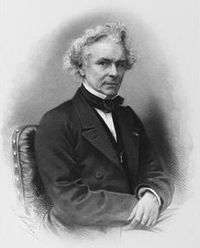Napoléon Henri Reber

Napoléon Henri Reber (21 October 1807, Mulhouse, Alsace – 24 November 1880, Paris) was a French composer.
Life and career
Reber studied with Anton Reicha and Jean François Lesueur, wrote chamber music, and set to music the new poems of the best French poets. He became professor of harmony at the Conservatoire de Paris in 1851 and succeeded Fromental Halévy as professor of composition in 1862, was inspector of the branch conservatories from 1871, and was elected to George Onslow's chairman in the Académie française in 1853.
His instrumental arrangement of Frédéric Chopin's Funeral March from the Funeral March Sonata was played at the graveside during Chopin's burial at Père Lachaise Cemetery in Paris on 30 October 1849.
He was made a chevalier of the Legion of Honour in 1855, and an officer in 1870. On his death, he was succeeded as a member of the Institut by Camille Saint-Saëns. Notable students include Adolphe Danhauser and Jules Massenet.
Works
Among his works are a ballet, Le Diable amoureux (written jointly with François Benoist, 1840); the comic operas, Le nuit de Noël (1848), Le père Gaillard (1852), Les papillotes de M. Benoist (1853), and Les dames capitaines (1857); four symphonies, and much chamber music. He wrote a Traité d'harmonie (1862), which went through many editions.
Reber's compositions include a string quintet (his opus 1; with extra cello),[1] two string quartets,[2] a piano quartet (1866) and seven piano trios,[3] and the four symphonies mentioned above:[4]
- Symphony no. 1 in D minor [5]
- Symphony no. 2 in C major (published by Richault of Paris[6])
- Symphony no. 3 in E♭ major (apparently by 1850; published by Richault of Paris [7])
- Symphony no. 4 in G major (apparently by 1850; published by Richault of Paris [8])
Notes
- ↑ Reber's string quintet. OCLC 18698671
- ↑ Reber's Grand Quartet in B-flat, opus 4. and his "Little" Quartet in D-flat, Op. 5 OCLC 18671454
- ↑ Randel, Don Michael (1996). The Harvard Biographical Dictionary of Music at Google Books. Cambridge: Harvard University Press. Page 731.
- ↑ Rosenkranz, A. (1902). Novello's catalogue of orchestral music: a manual of the orchestral literature of all countries at Google Books, New York: Novello, Ewer & Co., page 60. OCLC 13278734.
- ↑ published (in full score) by Richault of Paris in 1858, according to the Bibliographie de la France (a weekly journal of copyright registrations), 2 October 1858 issue. Anton Schindler in his Biographie von Ludwig van Beethoven (1845) (Beethoven in Paris, p.50) mentions that this work was performed in a concert in 1824?5? suggesting a rather earlier date (though he gives only "Reber"'s first symphony and no key, allowing the possibility that it may have been another composer of the same name.
- ↑ Symphony 2. Composed and performed by 1840; mentioned in La revue de Paris (1840), Volume 26, Page 132. Also see OCLC 19684291
- ↑ Symphony 3. OCLC 23368331
- ↑ Symphony 4. OCLC 23062314
References
-
 This article incorporates text from a publication now in the public domain: Gilman, D. C.; Thurston, H. T.; Colby, F. M., eds. (1905). "Reber, Napoléon Henri". New International Encyclopedia (1st ed.). New York: Dodd, Mead.
This article incorporates text from a publication now in the public domain: Gilman, D. C.; Thurston, H. T.; Colby, F. M., eds. (1905). "Reber, Napoléon Henri". New International Encyclopedia (1st ed.). New York: Dodd, Mead.
External links
- Free scores by Napoléon Henri Reber at the International Music Score Library Project
-
 "Reber, Napoleon Henry". Encyclopedia Americana. 1920.
"Reber, Napoleon Henry". Encyclopedia Americana. 1920.